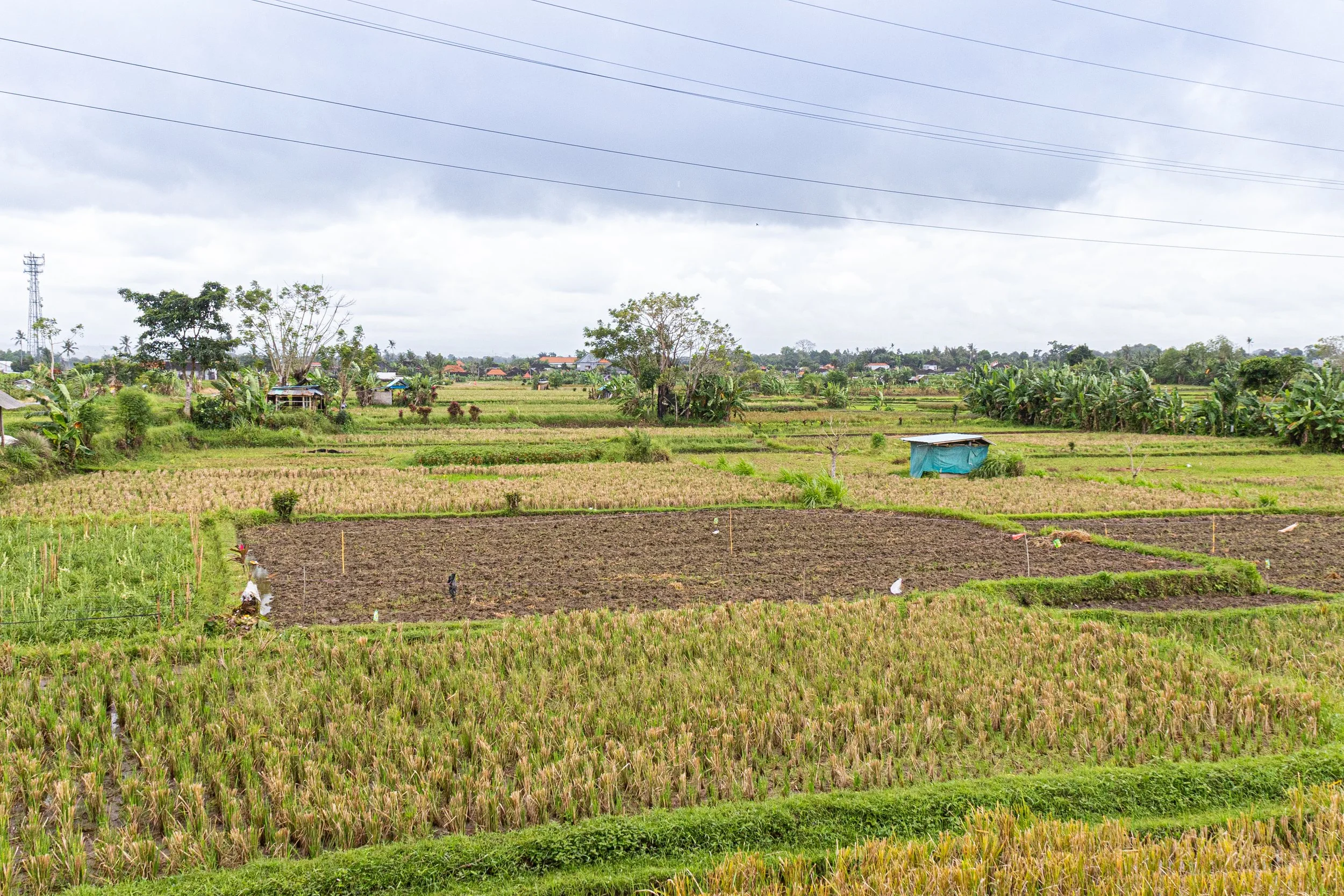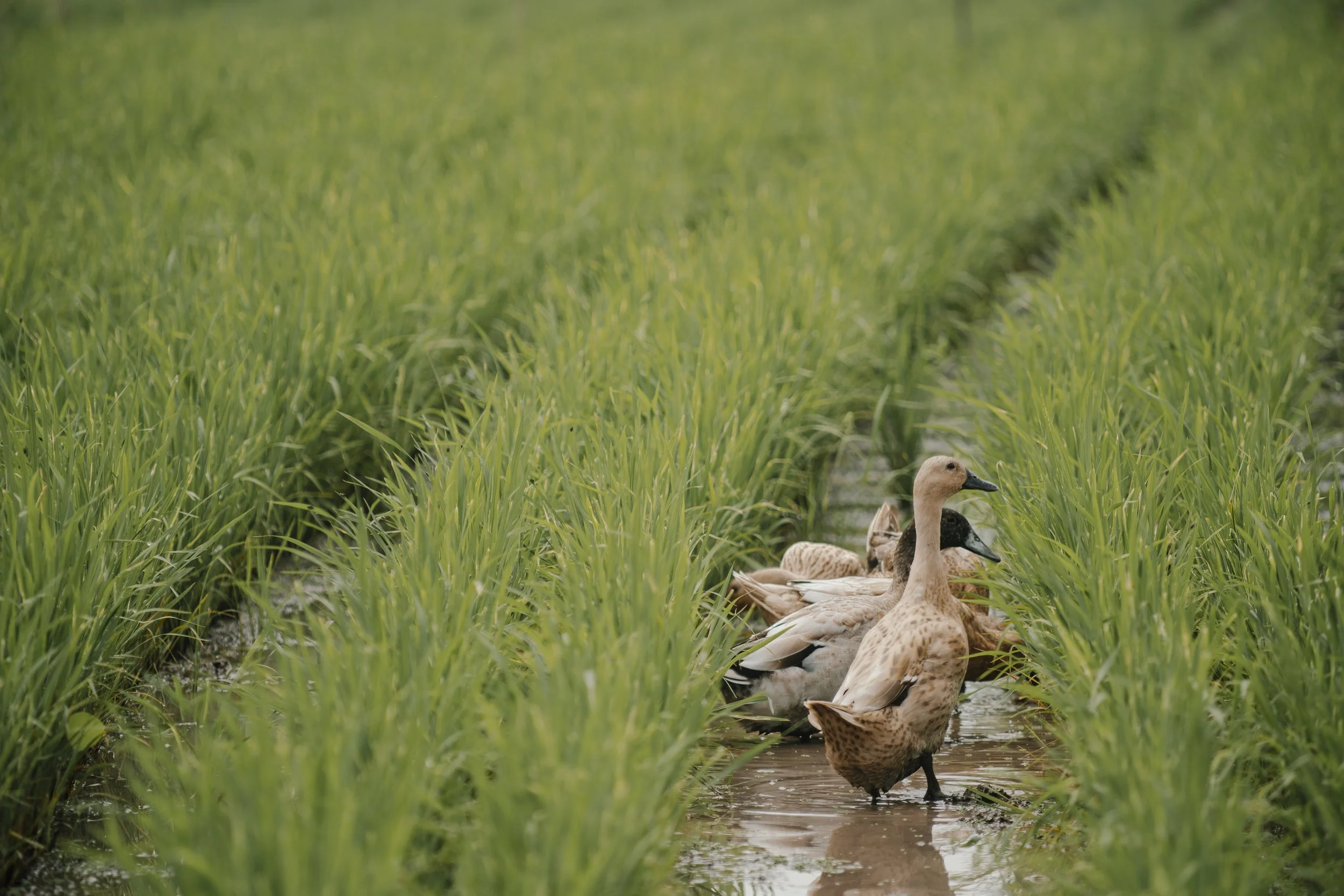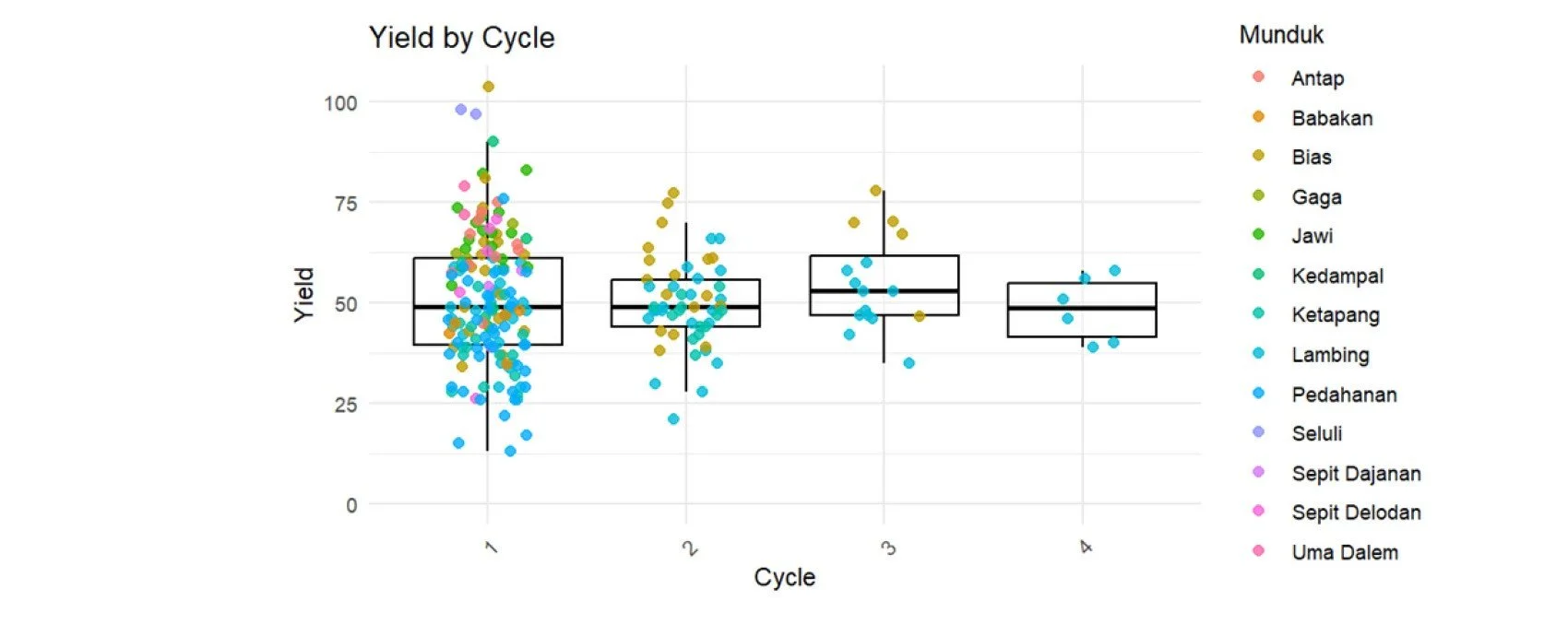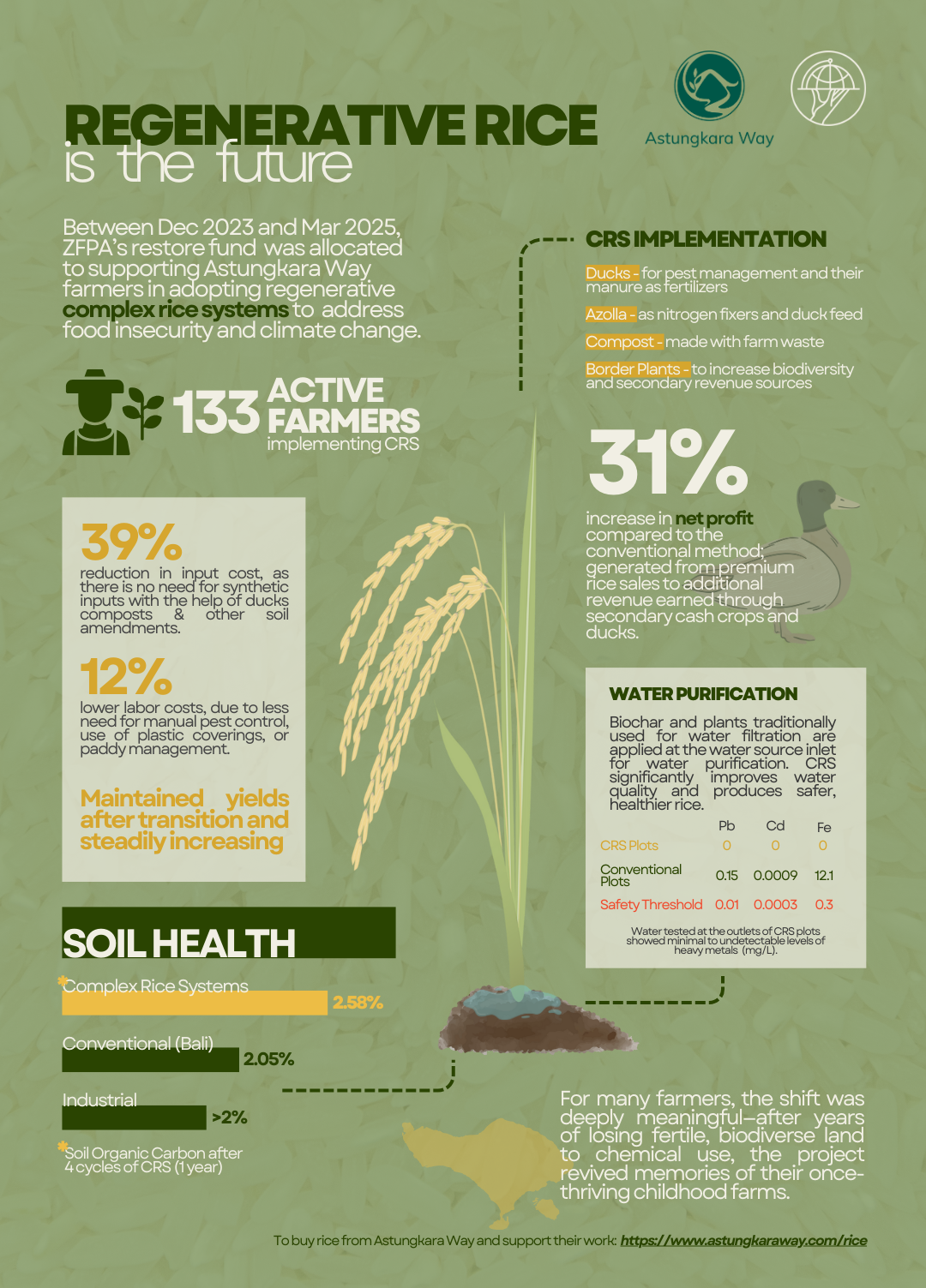Astungkara Way Phase 2 Project Final Update
As the dominant crop in Bali’s agricultural industry and a staple food across the world, rice is undoubtedly the ideal crop for regenerative adoption. Since 2023, Zero Foodprint Asia has supported Astungkara Way to implement a regenerative rice cultivation model to combat the dual challenges of food insecurity and climate change. 2025 also marked a significant year as Astungkara Way was listed as one of the finalists of the Food Planet Prize. Such profound recognition provides a clear statement to the world that it is time for collective change in the way we farm our food.
Project Development
During the first phase, agronomists and the reNature team provided technical support for farmers and community members of Astungkara Way, assisting them in adopting Complex Rice Systems (CRS). The Astungkara Way team took the lead in the second phase, expanding their footprint and converging more rice farmers to the nature-first practices with two goals in mind:
To increase overall farm productivity through ecosystem synergies-producing secondary cash crops and nourishing subsistence crops for farming families, all through ecologically sustainable practices.
To improve rice yields, more importantly, stabilize them in the face of climate change.
The second phase of scaling further included more youth involvement and data collection on production yield, economic implications, soil health, and biodiversity etc. We are incredibly pleased to see the progress Astungkara Way has achieved in two years, spanning over 16 hectares of land across 8 Subaks (cooperative irrigation system paddies) and 16 Munduks (upper elevation/slope) with 138 active farmers cultivating rice with CRS.
CRS Implementation
For farmers joining the regenerative journey, the Astungkara Way team offers a structured capacity-building program with 16 modules, covering topics such as planting techniques, natural pesticide and fertilizer production, agroecosystem management, pest and weed control, and harvesting methods. CRS practices included the integration of plant leguminous border crops such as Crotalaria juncea and Vigna unguiculata L. which enhances nitrogen availability; Azolla as a nitrogen-fixing crop, ducks for pest and nutrient management, compost, biochar, and Jarwo planting pattern using Sertani rice variety for optimal spacing, sunlight penetration, and yield. Data collection comparing different planting patterns and rice varieties has also shown Jarwo-Sertani as a clear winner.
Agronomic Success
Since adopting Complex Rice Systems and ditching chemical inputs, farmers have seen incredible positive changes in production yield, net profit, and cost reduction.
Yield Improvement – While it is expected that farmers will experience a decline in yield during the initial transitioning stages from conventional methods to regenerative practices, CRS farmers, after several cycles, are able to catch up to pre-transition levels with more stable yields. (Figure 1.)
Cost Reduction – With no synthetic input but with the additional help of little quacking heroes, CRS farmers achieved a 39% reduction in input cost, from an average production cost of 2.18USD for 1 are (conventional) to 1.33USD (CRS). Manpower power needed for manual pest monitoring, plastic coverings, and paddy control also declined – a labor cost reduction of approximately 12%, from 3.63USD per-are per cycle (conventional) to 3.19 USD (CRS).
Net Profit Increase – From premium rice sales to additional revenue generated through secondary cash crops and ducks, CRS earned a 31% increase in net profit compared to the conventional method. The increasing trend is nonetheless observed consistently across different planting cycles, a truly promising production method.
Figure 1. Rice yield progression from Cycle 1 to Cycle 4, showing a gradual increase in average yield, reaching approximately 53kg/are, which is comparable to the typical yield of conventional rice farming of 54kg/are.
Ecological Success
With some farmers already farming regeneratively for over 4 cycles, their environmental changes are becoming increasingly evident. These significant changes are restoring life both below and above the soil, helping to establish a more resilient ecosystem and a stronger natural carbon sink.
Soil health improvement – In contrast to a conventional plot with just 2.05% Soil Organic Carbon (SOC), the CRS plot reached 2.58% after four cycles. As previously discussed, simply maintaining SOC is already challenging due to biomass loss and natural decomposition, making any increase a significant achievement. Industrial plantations typically record SOC levels below 2%, highlighting how exceptional this gain is. Behind the >0.5% difference is that it took a village to make this improvement possible.
Water purification – Although regenerative practices are not a guarantee for heavy metal removal, studies have found that bioremediation, such as biochar, has the potential for removing contamination and soil amelioration. Figure 2 shows the difference in heavy metal content (copper, lead, cadmium, and iron) between conventional and CRS rice paddies, in which CRS plots distinctly produce safer and cleaner rice.
Biodiversity enhancement – To evaluate above-ground biodiversity levels, the Astungkara Way team used the Shannon-Wiener Index and surveyed fields for data collection. The Shannon-Wiener Index determines species (specifically insects) richness and evenness, where CRS plots reached 1.45 as opposed to conventional plots’ 1.03. While 1.5 is considered a good benchmark (Larekeng et al., 2022), we believe CRS plots will reach this threshold in no time with the continuous implementation of regenerative practices.
These ecological improvements not only bring life back to the land but also create a broader spectrum of positive externalities, including beautifying the local landscape and a healthier environment for farmers, ducks, consumers, and other living organisms.
Social and Cultural Success
During the first phase, farmers provided positive feedback in terms of knowledge gained, income, added value in religious, recreational & tourism activities, and dietary intake. The second phase expanded these social and cultural gains. The Astungkara Way team has grown to eight dedicated members working nonstop to scale CRS in Bali, and their collaboration with a local university has also created employment opportunities and increased youth participation in the agricultural sector.
Furthermore, the team discovered that the transition was deeply meaningful to many farmers involved, as they had witnessed the loss of fertile, biodiverse lands as a result of intensive use of chemical inputs. The project enabled them to relive and revitalize their childhood memories of thriving farmlands. Check out their stories and testimonies from Astungkara Way’s video!
Project End and Next Steps
The project is not without its challenges, such as dropouts and difficulties in outreach. However, with the majority still committed to the cause and positive results illustrated from their data collection, the Astungkara Way team remains confident in their work and will continuously explore new ways to scale CRS in Bali.
ZFPA’s partnership with Astungkara Way has now come to a close. We are sincerely grateful for their dedication and inspired by the progress and impact they’ve made over the past two years. Most importantly, we extend our heartfelt thanks to our restaurant partners and their diners, whose continued support has been vital in advancing the regenerative transition for thousands of farmers across the region.
References:
Gomez, F., Carcedo, A., Mean, C.M. et al. A dataset for soil organic carbon in agricultural systems for the Southeast Asia region. Sci Data 11, 374 (2024). https://doi.org/10.1038/s41597-024-03213-3
Awasthi, G., Nagar, V., Mandzhieva, S., Minkina, T., Sankhla, M. S., Pandit, P. P., Aseri, V., Awasthi, K. K., Rajput, V. D., Bauer, T., & Srivastava, S. (2022). Sustainable Amelioration of Heavy Metals in Soil Ecosystem: Existing Developments to Emerging Trends. Minerals, 12(1), 85. https://doi.org/10.3390/min12010085
Larekeng, S. H., Nursaputra, M., Nasri, N., Hamzah, A. S., Mustari, A. S., Arif, A. R., Ambodo, A. P., Lawang, Y., & Ardiansyah, A. (2022). A Diversity Index Model based on Spatial Analysis to Estimate High Conservation Value in a Mining Area. Forest and Society, 6(1), 142–156. https://doi.org/10.24259/fs.v6i1.12919







